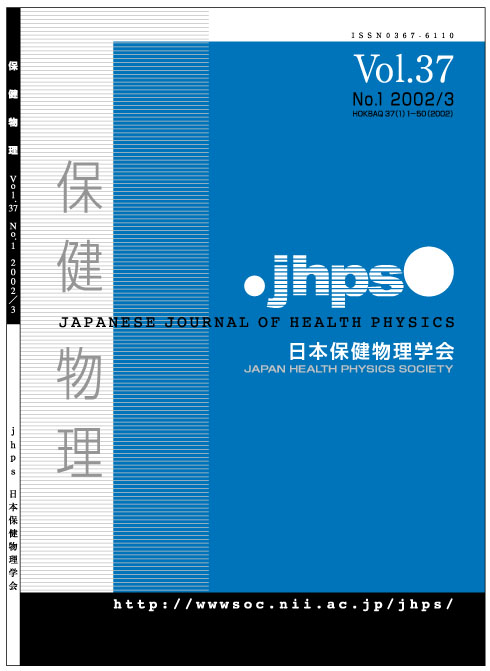All issues

Volume 48 (2013)
- Issue 4 Pages 159-
- Issue 3 Pages 123-
- Issue 2 Pages 61-
- Issue 1 Pages 1-
Volume 48, Issue 3
Displaying 1-10 of 10 articles from this issue
- |<
- <
- 1
- >
- >|
Color Topics
-
Article type: Color Topics
2013 Volume 48 Issue 3 Pages 123
Published: 2013
Released on J-STAGE: December 10, 2013
JOURNAL FREE ACCESSDownload PDF (1254K) -
-Focused on Issues in Low-Dose Radiation Research-Article type: Color Topics
2013 Volume 48 Issue 3 Pages 124
Published: 2013
Released on J-STAGE: December 10, 2013
JOURNAL FREE ACCESSDownload PDF (1150K) -
―Visually Grasping the Influence of the Accident―Article type: Color Topics
2013 Volume 48 Issue 3 Pages 124a
Published: 2013
Released on J-STAGE: December 10, 2013
JOURNAL FREE ACCESSDownload PDF (1150K)
Foreword
-
Noriah MOD ALIArticle type: Foreword
2013 Volume 48 Issue 3 Pages 127-128
Published: 2013
Released on J-STAGE: December 10, 2013
JOURNAL FREE ACCESSDownload PDF (158K)
Current Topics
-
Kazuo SAKAIArticle type: Current Topics
2013 Volume 48 Issue 3 Pages 129-130
Published: 2013
Released on J-STAGE: December 10, 2013
JOURNAL FREE ACCESSDownload PDF (269K) -
-Think about the Application of the New Dose Limit for the Lens of the Eye-Chiyo YAMAUCHI-KAWAURAArticle type: Current Topics
2013 Volume 48 Issue 3 Pages 130-133
Published: 2013
Released on J-STAGE: December 10, 2013
JOURNAL FREE ACCESSDownload PDF (472K) -
-Focused on Issues in Low-Dose Radiation Research-Haruyuki OGINO, Takashi OHBAArticle type: Current Topics
2013 Volume 48 Issue 3 Pages 134-138
Published: 2013
Released on J-STAGE: December 10, 2013
JOURNAL FREE ACCESSDownload PDF (946K)
Original Paper
-
-For the Public around Tokai-mura, Ibaraki-Masanori TAKEYASU, Shuichi SUMIYA, Sadaaki FURUTAArticle type: Original Paper
2013 Volume 48 Issue 3 Pages 141-149
Published: 2013
Released on J-STAGE: December 10, 2013
JOURNAL FREE ACCESSOn the basis of the measurement results of airborne radionuclide concentrations in the Nuclear Fuel Cycle Engineering Laboratories, Japan Atomic Energy Agency, the committed effective dose to adults and the committed equivalent dose to thyroid of infants by inhalation were estimated for various indoor and outdoor exposure scenarios. It was demonstrated that the indoor to outdoor airborne radionuclide concentration ratio had a dominant effect on the dose estimate. The committed effective dose to adults was estimated to 0.098 mSv, and the committed equivalent dose to thyroid of infants was 1.8 mSv. These doses were about 1/6 and about 1/9, respectively, compared to the provisional ones with such assumptions as continuous outdoor stay.View full abstractDownload PDF (421K)
Note
-
Nobuyoshi ISHII, Keiko TAGAMI, Isao KAWAGUCHI, Shigeo UCHIDAArticle type: Note
2013 Volume 48 Issue 3 Pages 150-155
Published: 2013
Released on J-STAGE: December 10, 2013
JOURNAL FREE ACCESSPotting soil can be often composed of variety of soils such as Akadamatsuchi, Kurotsuchi, and so on. In this study, root uptake of radiocesium (134Cs, 137Cs) by mini cabbage growing on various potting soils was studied. Three kinds of potting soils that contained any one of radiocesium contaminated Akadamatsuchi, leaf-mold and sludge were used for planting the mini cabbage. Concentrations of radiocesium differed among these potting soils: 3.4 × 101 Bq/kg in soil with Akadamatsuchi, 2.4 × 103 Bq/kg in soil with leaf-mold, and 3.5 × 103 Bq/kg in soil with sludge. At the harvest time, the concentrations of radiocesium in the mini cabbage were below 100 Bq/kg, which is the new standard limit for general foods by Japanese guidelines. The highest soil-to-plant transfer factor of 0.13 was observed for the soil with Akadamatsuchi. In addition to the high transfer factor, Akadamatsuchi is the most commonly used material for potting soils, and thus it may be necessary to pay attention to the radiocesium contamination in Akadamatsuchi. Foliar uptake of radiocesium by the mini cabbage was also studied, but the concentration of radiocesium did not increase in the plant under our experimental conditions.View full abstractDownload PDF (479K)
From Japan to the World
-
-Visually Grasping the Influence of the Accident-Japan Atomic Energy AgencyArticle type: From Japan to the World
2013 Volume 48 Issue 3 Pages 156-157
Published: 2013
Released on J-STAGE: December 10, 2013
JOURNAL FREE ACCESSDownload PDF (328K)
- |<
- <
- 1
- >
- >|